| Home |
| Acknowledgments |
| Conventions |
| Glossary |
| Maps |
| References |
| Links |
| Articles |
| Thumbnails |
| Species
list |
| Family |
| Next
species |
Additional Photos
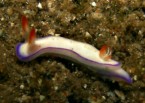
side
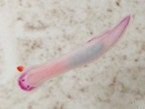
underside

rhinophores

young
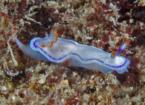
violet stalks
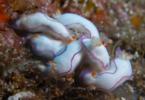
on food sponge

mating
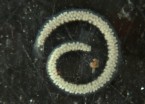
egg mass
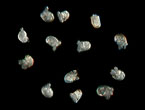
veligers
_______________
GALLERY

Thorunna daniellae (Kay & Young, 1969)
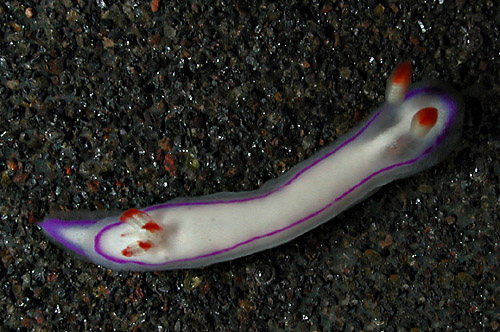
| Maximum size: about 25 mm
(Hoover, 2006). Identification: The body of this small, slender nudibranch is opaque white with a magenta line (sometimes interrupted) encircling the notum just inside the mantle margin. The rhinophore stalks are usually translucent (though, sometimes, tinged with violet), with the clubs orange-red on the anterior side and opaque white on the posterior side. The gills are opaque white with orange-red tips. In very young animals, the notum is translucent and has a herringbone pattern of embedded white spicules beginning between the rhinophores and ending at the gills. It may be distinguished from Thorunna kahuna by the lack of prominent opaque-white mantle glands around the posterior margin. It also has an opaque white (rather than translucent pink) notum when mature and a boundary between the orange and white pigment on the rhinophores that is angled rather than straight. Natural history: Thorunna daniellae is a moderately common diurnal species found on rocky bottoms. It occurs at moderately exposed to highly exposed locations from 5-27 m (16-90 ft) and vibrates its gills. It lays a pale-peach to cream egg mass that hatches in four to six days in the laboratory and flattens its branchia while mating. It appears to feed on a variety of sponges. (Note 1) Distribution: Big Island, Maui, Oahu, Kauai, Niihau, Midway and Kure: widely distributed in the Indo-Pacific. Taxonomic notes: This species was listed as Hypselodoris daniellae in Kay, 1979, Kay & Young, 1969 and Kay & Schoenberg-Dole, 1991. It was named for malacologist Danielle Fellows. It's referred to as "Danielle's Thorunna" in Hoover, 1998 and as "Danielle's nudibranch" in Hoover, 2006. It was first reported in Hawaii from Ala Moana, Oahu in March, 1962 (Kay & Young, 1969). There's some chance that animals with violet rhinophore stalks could be distinct. Photo: CP: 8 mm: near McGregor Point, Maui; Oct. 9, 2003. Observations and comments: Note 1: Four of five animals associated with a pink sponge in i-Nat photos had interrupted submarginal lines. The 5th was a "normal" animal paired with one of the others. Although segregation by food might suggest a cryptic split, the latter case would argue against it... |
| Thumbnails |
Species
list |
Family | Next species | Top |